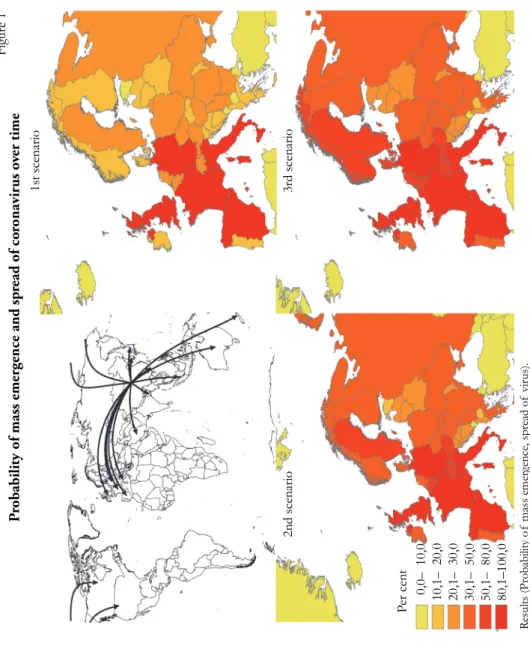VISUALIZATIONS
Regional Statistics, Vol. 10. No. 2. 2020: 228–231; DOI: 10.15196/RS100210
How coronavirus spread in Europe over time: national probabilities based on migration networks
Áron Kincses
Hungarian Central StatisticalOfffice E-mail: aron.kincses@ksh.hu
Géza Tóth
Hungarian Central StatisticalOfffice E-mail: geza.toth@ksh.hu
Keywords:
international migration, migration networks, coronavirus
Global migration trends (Hatton−Williamson 2005, Bálint et al 2017, Farkas–Dövényi 2018) today differ from those in previous centuries in terms of both the number of people migrating (as of 2017, 272 million people live in a country other than their country of origin) as well as the geographical, economic, and cultural distance between sending regions and destination countries. The interconnection between countries is constantly growing, relationships are expanding through migration, and people's movement is increasing.
Migration shows strong territorial concentration (Winders 2014); in 2019, half of the global migrant population lived in nine countries. In international migration, there are centres (large host countries) and global migration destinations, which attract migrants over long distances. Such hubs include the USA, Canada, Australia, the UK, Germany, France and Spain.
Close migration relationships mean strong exposure and vulnerability to the spread of infectious diseases. The calculation does not assume that infection can only be caused by migration, but states that migration relationships between countries, that is, their network, well represent the spread of infections between countries.
Methodological notes for establishing migration links
There is a close relationship between two countries when there is international migration (Wimmer−Schiller 2002, Novotný–Pregi 2018, Lados–Hegedűs 2019) between them, that is, someone moved from one (birth) place to another (current residence). Only movements above a threshold are considered by the network (Ba-
How coronavirus spread in Europe over time:
national probabilities based on migration networks 229
Regional Statistics, Vol. 10. No. 2. 2020: 228–231; DOI: 10.15196/RS100210
rabási 2016), as a small number of international migrants between two large countries does not necessarily represent a real migration link (Castles 2010; Castles–
Miller 2013). In other words, the network connects two countries only if the number of migrants between them is relevant and asymmetric. That is,
, = → − →
+
is above a fixed threshold µ. Here, M [X → Y] is the population density of country Y born in country X and N (X) is the population of country X, μ∈ {-1; +1}, μ∈R.
If q (A, B)> µ, a migration link from country A to country B is created; if not, there is no such link between the two countries. This allows different grids to be edited depending on the µ parameter.
Situation in Europe
1.2 million people born in China live in Europe (UN 2019). European countries most densely populated by Chinese people (Italy, the UK, Spain, Germany, and France) are home to 120-300,000 Chinese per country. Italy, the UK, Spain, Germany (Glorius 2018), and France are global migration centres and also the countries most infected with coronavirus.
In the following, we estimate the magnitude of the Chinese migration impact on European countries by creating scenarios for the temporal spread of the coronavirus at the national level.
Set up scenarios
Within real migration networks (Barabási 2016), their topology shows the „distance”
between countries, that is how "far away" they are from China and how many countries they are connected to. There is an inverse relationship between the distance in the network and the probability of propagation.
(Figure 1 (top left) shows the most important target areas for migration from China) With a longer migration distance, the rate at which the infection appears is as follows:
• Scenario 1: 5% (Lower values for Wuhan and surrounding regions) (top right)
• Scenario 2: 15% (Average spread for Lombardy and neighbouring regions in the case of Italy) (bottom left)
• Scenario 3: 25% (Highest penetration rate among regions of Italy) (bottom right)
230 Áron Kincses – Géza Tóth
Regional Statistics, Vol. 10. No. 2. 2020: 228–231; DOI: 10.15196/RS100210
1st scenario 3rd scenario2nd scenario Per cent
Figure 1 Probability of mass emergence and spread of coronavirusover time Results (Probability of mass emergence, spread of virus).80,1–100,050,1– 80,030,1– 50,020,1– 30,010,1– 20,00,0– 10,0
How coronavirus spread in Europe over time:
national probabilities based on migration networks 231
Regional Statistics, Vol. 10. No. 2. 2020: 228–231; DOI: 10.15196/RS100210 ACKNOWLEDGEMENT
This research was prepared with support from the Bolyai János Research Scholarship.
REFERENCES
BÁLINT, L.–CSÁNYI, Z.–FARKAS, M.–HLUCHÁNY, H.–KINCSES, Á. (2017): International migration and official migration statistics in Hungary Regional Statistics 7 (2): 101–123.
https://doi.org/10.15196/RS070203
BARABÁSI,A.L. (2016). Network Science Cambridge University Press, Cambridge.
CASTLES, S. (2010). Understanding global migration: a social transformation perspective Journal of Ethnic and Migration Studies 36 (10): 1565−1586.
https://doi.org/10.1080/1369183X.2010.489381
CASTLES,S.MILLER,M.J. (2013). The age of migration. International population movements in the modern world, Palgrave, London. https://doi.org/10.1007/978-1-349-26846-7 FARKAS,M.–DÖVÉNYI,Z. (2018): Migration to Europe and its demographic background
Regional Statistics 8 (1): 29–48.
https://doi.org/10.15196/RS080103
GLORIUS,B. (2018): Migration to Germany: Structures, processes, and discourses Regional Statistics 8 (1): 3–28. https://doi.org/10.15196/RS080101
HATTON,T.J.WILLIAMSON,J.G. (2005). Global Migration and the World Economy: Two Centuries of Policy and Performance MIT Press, Cambridge, MA.
LADOS,G.–HEGEDŰS,G: (2019): Return migration and identity change: A Hungarian case study Regional Statistics 9 (1): 150–167. https://doi.org/10.15196/RS090109 NOVOTNÝ, L.–PREGI, L: (2018): Visualization of migration using spatial interpolation
method in Hungary and Slovakia Regional Statistics 8 (2): 184–188.
https://doi.org/10.15196/RS080206
UNITED NATIONS, DEPARTMENT OF ECONOMIC AND SOCIAL AFFAIRS. POPULATION DIVISION (2019). Trends in International Migrant Stock 2019 (United Nations database) Available at:
https://www.un.org/en/development/desa/population/migration/data/estimat es2/estimates19.asp (accessed 1 March 2020).
WIMMER,A.–SCHILLER,N.G. (2002). Methodological nationalism and beyond: Nation–state building, migration and the social sciences. Global networks, Journal of transnational affairs, 2 (4): 301−334. https://doi.org/10.1111/1471-0374.00043
WINDERS, J. (2014): New immigrants destinations in global context. International Migration Review 48 (3): 149−179. https://doi.org/10.1111/imre.12140
DATA:
https://www.un.org/en/development/desa/population/migration/data/estimates2/estimat es19.asp
